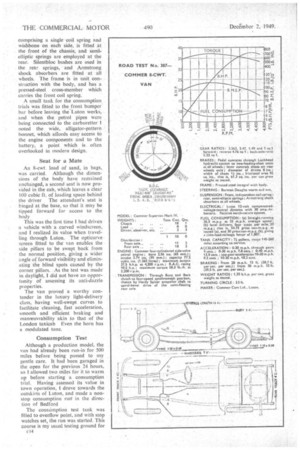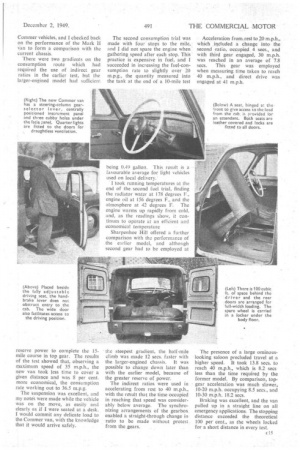New Engine of Increased Capacity Provides a More Flexible Performance
Page 59

Page 60

Page 61

If you've noticed an error in this article please click here to report it so we can fix it.
and Greater Economy. Independent Front Suspension System Affords Smooth Riding By L. J. COTTON, M.1.R.T.E.
A New Commer 8-cwt. Supervan
/THIS week "The Commercial Motor" is able to publish an exclusive road-test report of the new Commer Mark IV 8-cwt. Supervan, which is announced to-day. In outward appearance, apart from the side lamps now being fitted below the head lamps, there has been no radical change, but features of the new model include a larger engine, independent front suspension, curved windscreen. steering-column gear-selector lever and other modern developments.
The engine, retaining the 95-mm. stroke. of preceding models, has a 65-mm. bore, which increases the capacity by 80.5 c.c. to 1.265 litres. The compression ratio has been raised to 6.6 to 1 and the power output increased from 35 to 37.5 b.h.p. at 4,200 r.p.m.
Other details of the new power unit include fully floating gudgeon pins, which are retained in position by_circlips, a counterbalanced crankshaft, automatic timing-chain tensioner and a water pump. Former Commer van engines have relied on thermo siphon water cooling. Because of this change in cooling arrangements, the radiator and engine-water capacity has been reduced to 10i pints These alterations in design have been made without adding greatly to weight, and the combined weight of the complete engine and clutch is 308 lb., precisely 8 oz. more than that of the former unit. The crankcase and cylinder block are a monobloc iron casting, and 'Lo-Ex T-slot alloy pistons are used. The crankshaft has three main-bearing journals and the main, big-end and camshaft bearings are of steel-shell white-metal-lined pattern.
As in the former Commer van engine, the valves are positioned in the cylinder block and are operated through mushroom-headed tappets. The fan and water pump are driven by belt and pulley and are mounted as a unit at the front of the cylinder block. Crankshaft bearings and the duplex roller timing chain and sprockets are lubricated under pressure. Petrol is fed to the Solex downdraught carburetter by a mechanically operated fuel pump. An A.C. T-type air silencer is fitted to home models, and overseas chassis are to be equipped with an oil-bath air cleaner.
The side-mounted gearbox, with Borg Warner synchromesh arrangements for top, second and third ratios, is retained, with the selector control mounted on the steering column. The brake lever is on the off side of the driving seat, so that the cab floor is free from obstruction, and the driver can enter or leave from the near side without difficulty.
An independent suspension system,
comprising a single coil spring and wishbone on each side, is fitted at the front of the chassis; and semielliptic springs are employed at the rear. Silentbloc bushes are used in the rear springs, and Armstrong shock absorbers are fitted at all wheels. The frame is in unit construction with the body, and has a pressed-steel cross-member which carries the front coil spring.
A small tank for the consumption trials was fitted to the front bumper. bar before leaving the Lutonworks, and when the petrol pipes were being connected to the carburetter noted the wide, alligator-pattern bonnet, which affords easy access to the engine components and to the battery, a point which is often overlooked in modern design.
Seat for a Mate An 8-cwt. load of sand, in bags, was carried. Although the dimensions of the body have remained unchanged, a second seat is now provided in the cab, which leaves a clear 100 cubic ft. of loading space behind
the driver The attendant's seat is hinged at the base, so that it may be lipped forward for access to the body This was the first time I had driven a vehicle with a curved windscreen, and I realized its value when travelling through Luton. The opticurve screen fitted to the van enables the side pillars to be swept back from the normal position, giving a wider angle of forward visibility and eliminating the blind spots caused by the corner pillars. As the test was made in daylight, I did not have an opportunity of assessing its anti-dazzle properties.
The van proVed a worthy contender in the luxury light-delivery class, having well-swept curves to facilitate cleaning, fast acceleration, smooth and efficient braking and manreuvrability akin to that of the London taxicab Even the horn has a modulated tone.
Consumption Test Although a production model, the van had already been run-in for 500 miles before being passed to my gentle care. It had been garaged in the open for the previous 24 hours, so I allowed two miles for it to warm up before starting a consumption trial. Having assessed its value in town operation, I drove towards the outskirts of Luton, and made a nonstop consumption ruff in the direction of Bedford
The constimption test tank was filled to overflow point, and with stop watches set, the run was started. This course is my usual testing ground for Commer vehicles, and I checked back on the performance of the Mark 11 van to form a comparison with the current chassis.
There were two gradients on the consumption route which had required the use of indirect gear ratios in the earlier test, but the larger-engined model had sufficient reserve power to complete the 15mile course in top gear. The results of the test showed that, observing a maximum speed of 35 m.p.h., the new van took less time to cover a given distance and was 8 per cent. more economical, the consumption rate working out to 36.5 m.p.g.
The suspension was excellent, and my notes were made while the vehicle was on the move, as easily and clearly as if I were seated at a desk. I would commit any delicate load to the Commer van, with the knowledge that it would arrive safely. The second consumption trial was made with four stops to the mile, and I did not spare the engine when gathering speed after each stop. This practice is expensive in fuel, and I succeeded in increasing the fuel-consumption rate to slightly over 20 m.p.g., the quantity measured into the tank at the end of a 10-mile test being 0.49 gallon. This result is a favourable average for light vehicles used on local delivery.
1 took running temperatures at the end of the second fuel trial, finding the radiator water at 178 degrees F., engine oil at 156 degrees F., and the atmosphere at 42 degrees F. The engine warms up rapidly from cold, and, as the readings show, it continues to operate at an efficient and economical temperature
Sharpenhoe Hill offered a further comparison with the performance of the earlier model, and although second gear had to be employed at the steepest gradient, the half-mile climb was made 12 secs. faster with the larger-engined chassis. It was possible to change down later than with the earlier model, because of the greater reserve of power.
The indirect ratios were used in accelerating from rest to 40 m.p.h., with the result that the time occupied in reaching that speed was considerably below average. The synchronizing arrangements of the gearbox enabled a straight-through change in ratio to be made without protest from the gears. Acceleration from rest to 20 m.p.h„ which included a change into the second ratio, occupied 4 secs., and with third gear engaged, 30 m.p.h. was reached in an average of 7.8 secs. This gear was employed when measuring time taken to reach 40 m.p.h., and direct drive was engaged at 41 m.p.h.
The presence of a large ominouslooking saloon precluded travel at a higher speed. It took 13.8 secs. to reach 40 m.p.h., which is 8.2 secs less than the time required by the former model. By comparison, topgear acceleration was much slower, 10-20 m.p.h. occupying 8.5 secs., and 10-30 m.p.h. 18.2 secs.
Braking was excellent, and the van pulled up in a straight line on all emergency applications. The stopping distance exceeded the theoretical 100 per cent., as the wheels locked for a short distance in every test.












































































































